2016 Annual Merit Review Awards
Each year, at the Annual Merit Review and Peer Evaluation Meeting, the Hydrogen and Fuel Cells Program presents awards for contributions to the overall efforts of the Program and to recognize achievements in specific areas.
Joint Fuel Cell Technologies and Vehicle Technologies Office Award
U.S. DRIVE's Cradle-2-Grave Working Group
- Marcus Alexander, Electric Power Research Institute
- Steve Barnhart, FCA US LLC
- Mary Biddy, National Renewable Energy Laboratory
- Eric Bunnelle, ExxonMobil Refining & Supply Company
- Amgad Elgowainy, Argonne National Laboratory
- Dave Gohlke, AAAS Fellow supporting the U.S. Department of Energy
- Jeongwoo Han, Argonne National Laboratory
- Amit Kapur, Phillips66 Company
- Todd Ramsden, National Renewable Energy Laboratory
- Herie Soto, Shell Oil Products US
- Ian Sutherland, General Motors
- Laura Verduzco, Chevron Corporation
- Tim Wallington, Ford Motor Company
This award is for the outstanding effort of the U.S. DRIVE's C2G Working Group. On June 1, 2016, this team published the results of their multi-year effort in a report titled “Cradle-to-Grave Lifecycle Analysis of U.S. Light-Duty Vehicle-Fuel Pathways: A Greenhouse Gas Emissions and Economic Assessment of Current (2015) and Future (2025-2030) Technologies.” This work takes a deep dive into the opportunities for low-carbon vehicles and fuels providing a comprehensive lifecycle analysis of the cost and greenhouse gas (GHG) emissions of a variety of vehicle-fuel pathways, as well as the levelized cost of driving and cost of avoided GHG emissions. DOE, its partners, and the energy community will be able to cite this valuable work innumerable times.
Hydrogen and Fuel Cells Program Awards
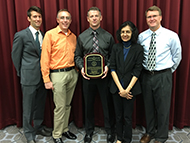
L to R: Danny Terlip, NREL; Chris Ainscough, NREL; Terry Johnson, SNL; Sunita Satyapal, Fuel Cell Technologies Office (FCTO); Joseph Pratt, SNL.
Hydrogen Fueling Infrastructure Research and Station Technology (H2FIRST) Team
- Joseph Pratt, Sandia National Laboratories
- Terry Johnson, Sandia National Laboratories
- Christopher Ainscough, National Renewable Energy Laboratory
- Daniel Terlip, National Renewable Energy Laboratory
This team award recognizes Joseph Pratt and Terry Johnson of Sandia National Laboratories and Christopher Ainscough and Daniel Terlip of the National Renewable Energy Laboratory for their outstanding contributions to the widespread commercialization of hydrogen infrastructure, including the successful deployment of the Hydrogen Station Equipment Performance (HyStEP) device. Special recognition must also be provided to Liam Quinlan, Angela Das, Steve Matthews, Brian Gourley, and Phil Horacek from Powertech for their exceptional attention to both technical details and schedule in meeting all deliverables. The primary purpose of the HyStEP device is to measure the performance of hydrogen fueling station dispensers with respect to the required fueling protocol standard. The HyStEP device was developed and demonstrated to reduce the time to commission hydrogen stations and can save many hours and resources since each automaker will not need to send individual fuel cell electric vehicles to every station to validate performance.
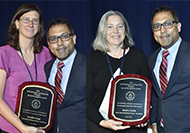
L to R: Jennifer Gangi, FCHEA; Reuben Sarkar, Office of Energy Efficiency & Renewable Energy (EERE); Sandra Curtin, FCHEA; Reuben Sarkar (EERE).
Jennifer Gangi and Sandra Curtin, Fuel Cell and Hydrogen Energy Association
This award recognizes Jennifer Gangi and Sandra Curtin of the Fuel Cell and Hydrogen Energy Association, formerly the U.S. Fuel Cell Council, for their outstanding contributions over the years to hydrogen and fuel cell market research and strategic analysis. Through the development of the annual Fuel Cell Technologies Market Reports, the Business Case for Fuel Cells reports, and the State of the States: Fuel Cells in America reports, all funded by the DOE's Fuel Cell Technologies Office, Jennifer and Sandra provide insightful and thoughtful market analysis that is critical to the developing hydrogen and fuel cell industry. These reports are consistently cited by academics, investors, government, and industry as highly valuable deliverables for the global market.
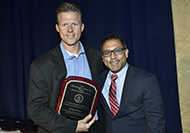
L to R: Bryan Pivovar, NREL; Reuben Sarkar, EERE.
Bryan Pivovar, National Renewable Energy Laboratory, and the H2 at Scale Lab Team
This award recognizes Bryan Pivovar from the National Renewable Energy Laboratory for his outstanding dedication and contributions in developing the H2 at Scale national-lab-wide "big idea." Bryan coordinated more than 60 contributors from 16 national labs and has cultivated support from multiple disciplinary areas across the U.S. Department of Energy. Both he and the entire team are recognized for their efforts, including conducting preliminary analyses and developing a white paper, demonstrating approaches to lower emissions and increase revenue opportunities in multiple energy sectors. H2 at Scale can enable greater market penetration of renewables by generating hydrogen as an energy carrier, which can then be used for energy storage or a feedstock or fuel across transportation, stationary power, and industrial applications.
Hydrogen Storage
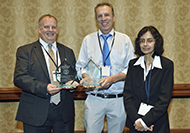
L to R: Ned Stetson, FCTO; Tom Gennett, NREL (accepting for Jeffrey Long and Craig Brown); Sunita Satyapal, FCTO.
Jeffrey R. Long, University of California–Berkeley, and Craig M. Brown, National Institute of Standards and Technology
This award recognizes Professor Jeff Long of the University of California–Berkeley and Dr. Craig Brown of the National Institute of Standards and Technology for their decades of dedication and achievements in adsorbent-based hydrogen storage materials development and characterization. Recently, Jeff synthesized the first adsorbent material (a metal organic framework) ever to conclusively show two molecular hydrogens bound to a single open metal cation via physisorption. Craig used neutron diffraction experiments to characterize and subsequently confirm the results, which offer a pathway for significantly improved hydrogen storage capacity for adsorbent-based hydrogen storage materials.
Fuel Cells
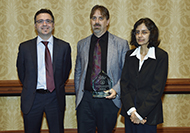
L to R: Dimitrios Papageorgopoulos, FCTO; Rod Borup, LANL; Sunita Satyapal, FCTO.
Rod Borup, Los Alamos National Laboratory
This award recognizes Rod Borup of Los Alamos National Laboratory for his outstanding role as the Director of DOE's Fuel Cell Consortium for Performance and Durability (FC-PAD). Rod has been instrumental in setting up and leading the core team of five national laboratories and in reaching out to industrial developers to accelerate improvements in polymer electrolyte membrane fuel cell (PEMFC) performance and durability. Rod is the Program Manager of the Fuel Cells Group at Los Alamos National Laboratory and has made extensive contributions to the fuel cell research community as a renowned expert in PEMFCs. He is a member of the U.S. DRIVE Fuel Cell Technical Team and co-chair of the DOE's Fuel Cell Technologies Office Durability Working Group.
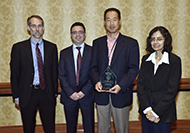
L to R: David Peterson, FCTO; Dimitrios Papageorgopoulos, FCTO; Yu Seung Kim, LANL; Sunita Satyapal, FCTO. (Not pictured: Cy Fujimoto.)
Cy Fujimoto, Sandia National Laboratories, and Yu Seung Kim, Los Alamos National Laboratory
This award recognizes Yu Seung Kim of Los Alamos National Laboratory and Cy Fujimoto of Sandia National Laboratories for their outstanding technical contributions and achievements in the development of alkaline exchange membrane (AEM) fuel cell technology. As a result of their work, this nascent technology is beginning to show promise for low-cost fuel cells and electrolyzers. Their continued collaboration since 2009 is an excellent example of how technology can be more effectively advanced through inter-lab partnerships. Working together these co-principal investigators investigated the degradation mechanism of AEM materials and subsequently developed novel AEMs that have shown unprecedented alkaline stability. The resulting membranes and membrane electrode assemblies have demonstrated good performance and durability under both fuel cell and electrolysis operating conditions, opening up opportunities in both fields.
Manufacturing R&D
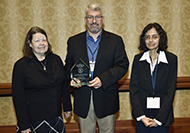
L to R: Nancy Garland, FCTO; Michael Ulsh, NREL; Sunita Satyapal, FCTO.
Michael Ulsh, National Renewable Energy Laboratory
This award recognizes Michael Ulsh of the National Renewable Energy Laboratory for his responsiveness and continued contributions to the advancement of fuel cell manufacturing and quality control. Mike has demonstrated new diagnostics to detect defects in fuel cell roll-to-roll goods for the Fuel Cell Technologies Office. Mike's efforts have also led to new opportunities in quality control and quality assurance, which are helping to solve manufacturing issues with fuel cell technologies that are now beginning to have impact in battery manufacturing. His diagnostic work has improved membrane material fabrication and, for the first time ever, this intellectual property is being commercialized through a Tech Transfer opportunity, paving the way for U.S. manufacturing leadership.
Market Transformation/Technology Validation
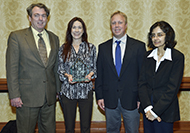
L to R: Pete Devlin, FCTO; Melanie Caton, NREL; Jason Marcinkoski, FCTO; Sunita Satyapal, FCTO.
Melanie Caton, National Renewable Energy Laboratory
This award recognizes Melanie Caton of the National Renewable Energy Laboratory for her continued commitment to the advancement of hydrogen infrastructure. Melanie has done a tremendous job as the project leader for the Brentwood Advanced Hydrogen Technologies Station being installed in Washington, D.C. She has interfaced effectively with multiple stakeholders, including federal agencies, city planning, code organizations, and technology developers, to maintain tight schedules. Her continued dedication and leadership skills have led the project from infancy to anticipated completion in July 2016.
Market Transformation
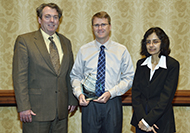
L to R: Pete Devlin, FCTO; Joseph Pratt, SNL; Sunita Satyapal, FCTO.
Joseph Pratt, Sandia National Laboratories
This award recognizes Joseph Pratt of Sandia National Laboratories for his dedication to and strong leadership in the advancement of hydrogen and fuel cell technologies in early markets. Joe is the project leader for the Fuel Cell Technologies Office's maritime power project, leading a diverse team including a seaport cargo business, U.S. Maritime Administration, the Coast Guard, and the University of Hawaii to demonstrate a pierside, zero emissions fuel cell power system. This approach replaces diesel generators and can greatly reduce emissions and petroleum use for pierside applications.
Safety, Codes, and Standards
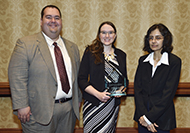
L to R: Will James, FCTO; Katrina Groth, SNL; Sunita Satyapal, FCTO.
Katrina Groth, Sandia National Laboratories
This award recognizes Katrina Groth of Sandia National Laboratories for her continued dedication and contribution to hydrogen safety and risk assessment through her relentless work in developing the Hydrogen Risk Assessment Model (HyRAM) toolkit software. The HyRAM toolkit incorporates numerous hydrogen behavior models into a user-friendly package and was designed to address key barriers to hydrogen infrastructure deployment, including limited access to safety data, lack of models describing hydrogen behavior, and challenges using technical data to revise standards. This valuable piece of software has the potential to broadly impact the hydrogen safety community and would not be possible without Katrina’s commitment and effort.
